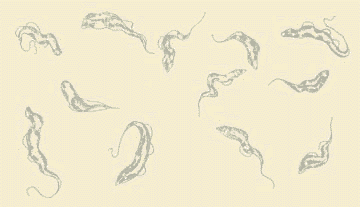

 |
 |
|||
| Lab Protocols (downloadable as pdf files). | |||||
Use the header menu to navigate to information and protocols for trypanosome culture and genetic manipulation. This page was primarily created as the definitive source of standardized protocols for use within the Cross lab. We decided to make them accessible to other labs that might find them useful. They are offered with no guarantees, although they work fine for us. In many cases, the protocols are variations of those that previous members of our lab or others have developed and published. We have tried to include attributions where appropriate. If you feel we have erred in this respect, please e-mail me. This effort was started in 2006 by members of the lab who are not necessarily the originators but have probably adapted earlier versions based on personal experience. Almost all have been edited by me, for clarity and to try to create a consistent style. We will try to keep these up-to-date, but you can e-mail me if you need to know if a specific protocol has been updated. This is an ongoing project. We hope you find it useful and we welcome any suggestions for improving its utility. If you click on the links below, pdf files will open in a new browser window. | |||||
| A list of characterized Lister 427 VSGs with the preferred nomenclature cross-referenced to MITat designations, lab-specific names and GenBank Accession numbers, can be downloaded as pdf with active links to GenBank. Please e-mail me if you have sequenced a new VSG that we should add to the list.
General-purpose buffer solutions etc (BUT TRY THIS LINK FOR A COMPREHENSIVE TREATISE ON BUFFERS, AND A 'BUFFER CALCULATOR') Affinity purification of antibodies (especially anti-peptide antibodies) Culture: please use the links at top of this page for the most up-to-date information. Chromatin Immunoprecipitation for high-throughput sequencing (ChIP-seq) DNA isolation: several protocols for different purposes E.coli competent cells for chemical transformation E. coli competent cells for electroporation EMSA for a telomere-binding protein FACS and IF on live trypanosomes Fluorescent In-Situ Hybridization (FISH) Luciferase and beta-galactosidase assays Transfection of bloodstream and procyclic trypanosomes If you transfect bloodstream forms the AMAXA NUCLEOFECTOR® II gave us up to (follow the links for test results as pdf) a 300-fold increase in transient transfection, as judged by luciferase expression, and about 70-fold increase in stable clones with about 25% viability of the input cells. These results were obtained during evaluation prior to purchase, in which we tested several buffer systems (Amaxa human T cell buffer was best) and programs side-by-side with the BTX machine that we have used for many years. We also found that substituting the Amaxa T-cell buffer for Cytomix alone gave a 10-fold increase in transient transfection in the BTX machine and the converse subsitution gave a 90% reduction of efficiency in the Nucleofector. So, the Amaxa buffer alone is far better than Cytomix, but its composition is proprietory. It does not appear to contain any of the proteins mentioned in various Amaxa patents. Stable transfection was evaluated using only one plasmid, pLEW82v4, which integrates into rRNA spacer regions. As they say, "your mileage may differ". We did not evaluate the efficiency of the Nucleofector for procyclic forms. Another lab has reported a far greater gain in stable transfection efficiency with the Amaxa Nucleofector (Burkard G, Fragoso CM & Roditi I. Mol Biochem Parasitol (2007) 153:220-3), which could be attributable to the different locus that was targeted or to the two-stage drug-selection protocol. We have not investigated further, but the claimed increase in efficiency is substantial and might be useful for you. | |||||